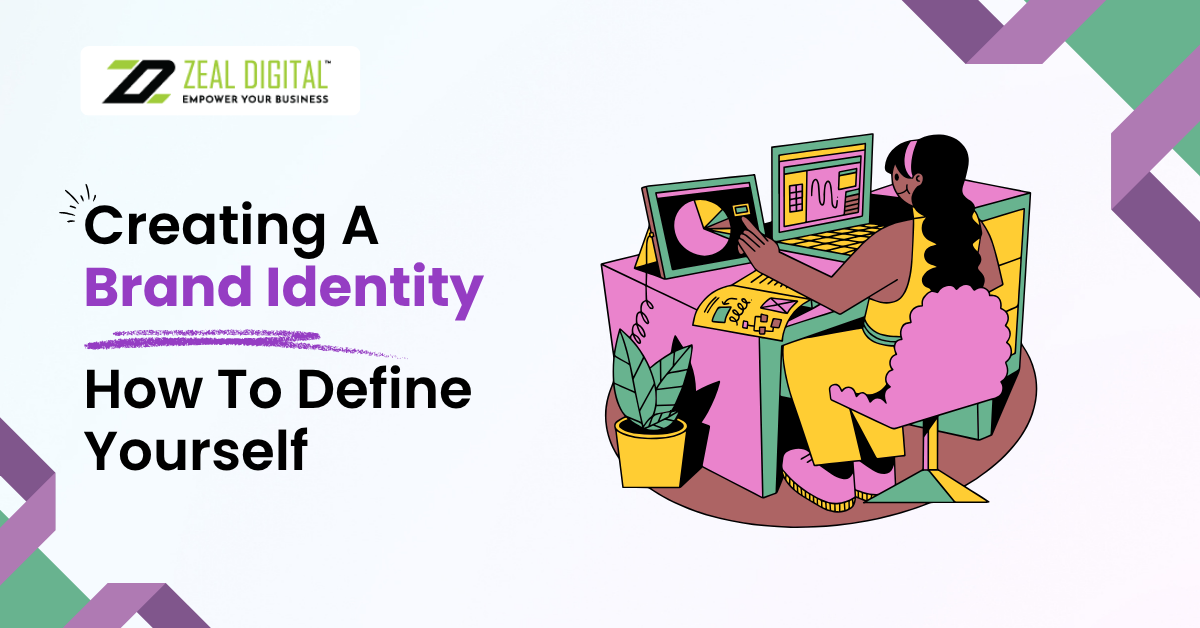Let’s be honest, in today’s fast-moving world, it is common to have immediate access to a product or any service. But that is not always enough to fulfil a purchase. Customers relate to brands that feel authentic and have something to offer. This is where a brand identity comes into focus.
Brand identity is the personality of a business. An identity explores the character of a person and so does a business with its logo. It is equally important to understand the focus of business and the reputation it holds.
Let’s focus on answering the primary question: What more does a business need to do to create a brand identity that stands out, holds and is considered trusted by numerous people?
What Brand Identity Really Means
Think of brand identity as everything that shapes how people see your business, your visuals, your tone, even your vibe. It’s the full package.
Branding is the big-picture work of managing perceptions. But brand identity? That’s what makes you instantly recognisable.
A solid identity does a few important things:
- Helps you stand out. There’s no shortage of competition. Your brand should cut through the noise.
- Makes you memorable. People remember how you made them feel.
- Keeps things consistent. A clear identity ties all your communication together.
- Builds emotional connection. Because loyalty comes from trust, not just transactions.
Without a clear sense of who you are, even the most innovative idea can struggle to land. So before you start marketing, you need to define what your brand means.
Step 1: Start with Purpose, Mission and Vision
Every great brand starts with a reason for existing. The mission describes what and why matters now; the vision clarifies the prospective direction.
For example, a social and environment-friendly fashion brand can define their mission as: Design innovative and stylish clothing that encourages and promotes eco-friendly practices in everyday life – Clothing for a better world, and envision as: Redefining fashion by making sustainability the norm.
Enjoy a guiding compass, your North Star, for every campaign, design decision, and client interaction.
Step 2: Define Your Core Values
What do you stand for when no one cares? That’s your core values.
Values like integrity, creativity, or sustainability define the interaction your team will have with the audience and the perception they will have on you. And these authentic values always let people trust you.
Step 3: Know Who You’re Talking To
A mistake that several companies make is that they create elaborate logos and don’t focus on who their target is.
The audience determines how you communicate, the tone of your words, the voicing, and the visuals. As such, take the time to learn what your audience is concerned about and what difficulties they face. What drives them to pick a particular brand and to neglect others is very important.
Find the answer to these questions through surveys, social media, and real-life interactions. When the audience is properly and effectively targeted, then the message is sure to be received and understood.
Step 4: Check Your Current Brand
Before you rebuild your brand from scratch, take a look at where you stand right now. A quick brand audit can tell you a lot.
Ask yourself:
- What do people currently think about our brand?
- Are our visuals and voice consistent?
- Where are we losing attention or trust?
You can’t improve what you don’t measure. This step gives you a clear foundation to grow from.
Step 5: Bring Your Brand to Life Visually
This is the fun part: your logo, colours, fonts, imagery. These are the cues that help people instantly recognise you.
Logo
Your logo doesn’t have to be fancy; just memorable and true to your brand’s spirit. Simplicity wins every time.
Colours
Colours evoke emotion. Blue feels calm and trustworthy. Green suggests balance and growth. Red is energetic and bold. Choose a palette that fits your personality, not just your industry.
Typography
Fonts have personality too. Serif fonts can feel classic and dependable; sans-serif fonts feel clean and modern.
Imagery
Keep your imagery consistent. Whether you use photos, illustrations, or icons, everything should look and feel like you.
Step 6: Develop Your Brand Voice
Your brand voice is your business’s way of “speaking.” Rather, it’s what differentiates a business’s words from anyone else’s.
Consider the following: Is your tone warm and informal? Relaxed and formal? Daring and funny?
By defining your tone, you can maintain it throughout your site, email, and social media replies. People trust what they are familiar with, and consistency with your voice builds trust.
Last but not least, storytelling is an extremely effective tool. Share your purpose for your brand, explain the difficulties that arose, along with what keeps you passionate. Your brand will be transformed into a community instead of just a business.
Step 7: Create a Seamless Brand Experience
With reputation and identity comes more than logos and taglines; it is also the totality of experiences that a person might have when they meet you in person or engage with you online.
- Website: Ensure it is in accordance with your style, ethic, and tone. It is always a first impression, so make that first impression a good one.
- Customer Service: Reputation is determined in the range of every conversation. A pleasant and useful staff member is a stronger addition to your brand and marketing than any advertisers you might have.
- Products or services: A brand promise is the fundamental basis of the value you promise to deliver to your customers; you should always stand by that brand promise.
- Social Media: Mute posts. Your name does not have to appear alongside your posts for people to instantly connect the posts to you, style and tone withstanding.
Step 8: Align Your Team
Here’s something many businesses forget: your employees are your brand.
If they don’t understand what you stand for, that disconnect shows. Train your team to live and breathe your brand values. Build a culture that reflects your identity inside and out.
And don’t just set it and forget it. Ask for feedback regularly from both employees and customers and be willing to evolve.
Step 9: Keep Evolving
A brand is not something you create once and decide to put in a drawer. Situations change, your market changes, customers change, and all your surrounding factors change.
Schedule brand health metrics at set intervals; if necessary, maintain the values, and modify the brand’s vision and engagement metrics, brand awareness, and increase the effectiveness.
Common Pitfalls to Avoid
Let’s talk about what not to do:
- Being inconsistent. Mixed visuals or messaging confuse people.
- Copying others. Inspiration is fine, imitation isn’t.
- Ignoring your audience. If you’re not listening, you’re missing the mark.
- Chasing trends. Trends fade. Your values shouldn’t.
The Takeaway
Building a brand identity isn’t just about looking good; it’s about being understood. It’s knowing who you are, why you matter, and how you want people to feel when they experience your brand.
When you get it right, everything clicks.Your marketing feels effortless. Your audience feels connected, and your business starts to grow in a way that feels authentic.
And if you’re focusing on visibility, especially locally, strategies like local SEO in Parramatta can help your brand show up where it matters most right in your community.
The takeaway? A strong brand identity isn’t a design exercise. It’s a promise. One that, when kept, builds lasting trust and loyalty.
FAQs:
2. Why is having a clear brand identity important?
A clear brand identity builds trust, recognition, and emotional connection. In a competitive market, customers gravitate towards brands that feel authentic and consistent. It’s what turns first-time buyers into loyal advocates.
3. How can a business define its brand purpose, mission, and vision?
Start by asking why your business exists beyond making a profit. Your purpose drives your passion, your mission describes what you do now, and your vision defines where you want to go. Together, they act as your compass for every design, campaign, and interaction.
4. What role do core values play in building a brand identity?
Core values shape how your business behaves and interacts with customers. They reflect what you stand for even when no one is watching. Values like honesty, creativity, and sustainability foster long-term trust and guide decision-making across your organisation.
5. How can a business make its visual identity stand out?
A distinctive visual identity combines simplicity with consistency. Use colours that evoke your brand’s personality, choose typography that fits your tone, and design a memorable logo. Keep imagery cohesive across platforms so people recognise you instantly, even without seeing your name.
6. How does brand voice influence customer perception?
Your brand voice defines how you “speak” to your audience. Whether warm and conversational or professional and bold, your tone should reflect your brand’s values and connect emotionally with your target market. Consistency across emails, social media, and marketing builds familiarity and trust.
7. How can local strategies enhance a brand identity?
Integrating local marketing tactics can make your brand feel more authentic and connected to its community. Engaging in regional storytelling, local partnerships, and tailored campaigns builds stronger relationships. For instance, focusing on local SEO in Parramatta with the help of a reputable marketing agency like Zeal Digital can help ensure your brand appears where your audience lives and searches.







